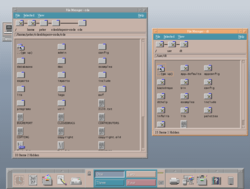SOLARIS OS
SOLARIS OS
Solaris is a Unix operating system originally developed by Sun Microsystems. It superseded their earlier SunOS in 1993. In 2010, after the Sun acquisition by Oracle, it was renamed Oracle Solaris.
Solaris is known for its scalability, especially on SPARC systems, and for originating many innovative features such as DTrace, ZFSand Time Slider. Solaris supports SPARC and x86-64 workstations and servers from Oracle and other vendors. Solaris is registered as compliant with the Single UNIX Specification.
Historically, Solaris was developed as proprietary software. In June 2005, Sun Microsystems released most of the codebase under the CDDL license, and founded the OpenSolaris open-source project. With OpenSolaris, Sun wanted to build a developer and user community around the software. After the acquisition of Sun Microsystems in January 2010, Oracle decided to discontinue the OpenSolaris distribution and the development model. In August 2010, Oracle discontinued providing public updates to the source code of the Solaris kernel, effectively turning Solaris 11 back into a closed source proprietary operating system. Following that, in 2011 the Solaris 11 kernel source code leaked to BitTorrent. However, through the Oracle Technology Network (OTN), industry partners can still gain access to the in-development Solaris source code. Source code for the open source components of Solaris 11 is available for download from Oracle.
Early releases of Solaris used OpenWindows as the standard desktop environment. In Solaris 2.0 to 2.2, OpenWindows supported both NeWS and X applications, and provided backward compatibility for SunView applications from Sun's older desktop environment. NeWS allowed applications to be built in an object-oriented way using PostScript, a common printing language released in 1982. The X Window System originated from MIT's Project Athena in 1984 and allowed for the display of an application to be disconnected from the machine where the application was running, separated by a network connection. Sun's original bundled SunView application suite was ported to X.
Sun later dropped support for legacy SunView applications and NeWS with OpenWindows 3.3, which shipped with Solaris 2.3, and switched to X11R5 with Display Postscript support. The graphical look and feel remained based upon OPEN LOOK. OpenWindows 3.6.2 was the last release under Solaris 8. The OPEN LOOK Window Manager (olwm) with other OPEN LOOK specific applications were dropped in Solaris 9, but support libraries were still bundled, providing long term binary backwards compatibility with existing applications. The OPEN LOOK Virtual Window Manager (olvwm) can still be downloaded for Solaris from sunfreeware and works on releases as recent as Solaris 10.
Sun and other Unix vendors created an industry alliance to standardize Unix desktops. As a member of the Common Open Software Environment (COSE) initiative, Sun helped co-develop the Common Desktop Environment (CDE). This was an initiative to create a standard Unix desktop environment. Each vendor contributed different components: Hewlett-Packard contributed the window manager, IBM provided the file manager, and Sun provided the e-mail and calendar facilities as well as drag-and-drop support (ToolTalk). This new desktop environment was based upon the Motif look and feel and the old OPEN LOOK desktop environment was considered legacy. CDE unified Unix desktops across multiple open system vendors. CDE was available as an unbundled add-on for Solaris 2.4 and 2.5, and was included in Solaris 2.6 through 10. In 2001, Sun issued a preview release of the open-source desktop environment GNOME1.4, based on the GTK+ toolkit, for Solaris 8. Solaris 9 8/03 introduced GNOME 2.0 as an alternative to CDE. Solaris 10 includes Sun's Java Desktop System (JDS), which is based on GNOME and comes with a large set of applications, including StarOffice, Sun's office suite. Sun describes JDS as a "major component" of Solaris 10. The Java Desktop System is not included in Solaris 11 which instead ships with a stock version of GNOME. Likewise, CDE applications are no longer included in Solaris 11, but many libraries remain for binary backwards compatibility.
The open source desktop environments KDE and Xfce, along with numerous other window managers, also compile and run on recent versions of Solaris.
Sun was investing in a new desktop environment called Project Looking Glass since 2003. The project has been inactive since late 2006.






